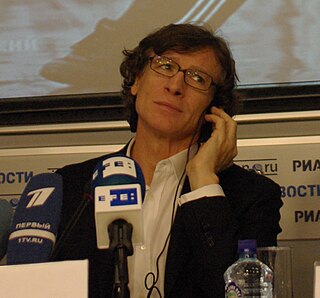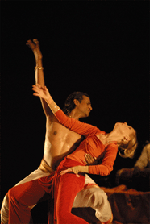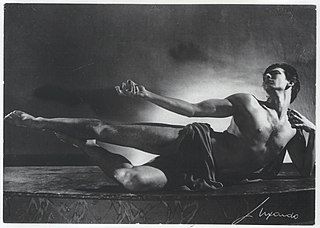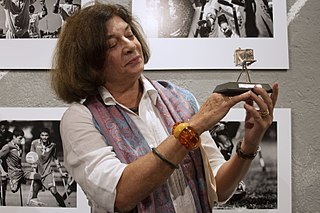See also
| This disambiguation page lists articles associated with the title Danza. If an internal link led you here, you may wish to change the link to point directly to the intended article. |
Danza is a musical genre.
Danza may also refer to:
| This disambiguation page lists articles associated with the title Danza. If an internal link led you here, you may wish to change the link to point directly to the intended article. |

El sombrero de tres picos is a ballet choreographed by Léonide Massine to music by Manuel de Falla. It was commissioned by Sergei Diaghilev and premiered in 1919. It is not only a ballet with Spanish setting but one that also employs the techniques of Spanish dance instead of classical ballet.
El amor brujo is a ballet composed in 1914–15 by Manuel de Falla to a libretto by Gregorio Martínez Sierra. In 1916, Falla arranged a rendition of the work for sextet and small orchestra and the following year he made a concert version, also for small orchestra. Later, he fashioned a piano suite from it and finally, a second ballet version (1925) that features expanded orchestration, elimination of the narration, small cuts and plot changes, and a different order to the numbers.

Baile folklórico, literally "folkloric dance" in Spanish, also known as ballet folklórico, is a collective term for traditional Mexican dances that emphasize local folk culture with ballet characteristics - pointed toes, exaggerated movements, highly choreographed. As mentioned below, baile folklórico owes its inception to Amalia Hernández Navarro. Baile folklórico differs from danzas and regional bailes. "Folk dances", that is, "dances that you will find in the villages, not on stage" were researched and disseminated by Alura Angeles de Flores. A good rule of thumb is if the woman raises her hands about her head, it is folklórico. Each region in Mexico, the Southwestern United States and Central American countries is known for a handful of locally characteristic dances.

Juan Ignacio Duato Bárcia, also known as Nacho Duato is a Spanish modern ballet dancer and choreographer. Since 2014, Duato is artistic director of the Berlin State Ballet.
Danza Contemporanea de Cuba is a contemporary dance company based in Havana, Cuba, combining modern American theatre, Afro-Caribbean dance styles and classical European Ballet.

Carolyn Carlson is an American born French nationalized contemporary dance choreographer, performer, and poet. She is of Finnish descent.

Ballet Hispánico is an American dance company based in Manhattan, New York. It was founded by the Puerto Rican/Mexican-American dancer and choreographer Tina Ramirez in 1970 and presents dances reflecting the experience of Hispanic and Latino Americans. It describes itself as "the foremost dance representative of Hispanic culture in the United States."
Guillermina Nicolasa Bravo Canales was a Mexican ballet dancer, choreographer and ballet director. She was co-founder of the academy of Mexican dance in 1947 and established together with Josefina Lavalle the national ballet company in Mexico City in 1948, which has been located in Querétaro since 1991 where she also established the national center of contemporary dance. Bravo is considered as main figure of modern Mexican dance. Her sister Lola (1918–2004) was a notable stage actress.
NellieFrancisca Ernestina Campobello Luna was a Mexican writer, notable for having written one of the few chronicles of the Mexican Revolution from a woman's perspective. Cartucho chronicles her experience as a young girl in Northern Mexico at the height of the struggle between forces loyal to Pancho Villa and those who followed Venustiano Carranza. She moved to Mexico City in 1923, where she spent the rest of her life and associated with many of the most famous Mexican intellectuals and artists of the epoch. Like her half-sister Gloria, a well-known ballet dancer, she was also known as a dancer and choreographer. She was the director of the Mexican National School of Dance.
Esteban Berlanga is a Spanish ballet dancer and a principal dancer with the Compañía Nacional de Danza, Madrid.

The Spanish National Dance Company was founded in 1979 under the name Ballet Nacional de España Clásico. Its first director was dancer Victor Ullate, followed by Maria de Avila, Ray Barra, Maya Plisetskaya, Nacho Duato, Hervé Palito, José Carlos Martínez, and Joaquín de Luz.

Sergei Vladimirovich Polunin is a Ukrainian-born ballet dancer, actor and model. He has Ukrainian, Russian, and Serbian citizenship, but has "always regarded himself as Russian".
La Cebra Danza Gay is a dance troupe founded in 1996 by José Rivera Moya in Mexico City. It is the first in Mexico to focus nearly exclusively on gay community and the issues it faces. The groups as a repertoire of over ten major works including Danza del mal amor o mejor me voy, which has been performed over 100 times. La Cebra has appeared in various locations in Mexico and has had appearances in the United States and France.
José Carlos Martínez is a Spanish dancer and choreographer, Danseur Étoile of the Paris Opera Ballet, and since December 2010, artistic director of the Spanish National Dance Company.

Guido Lauri was an Italian dancer, actor, choreographer, ballet master, company director.
La danza is an opera by the composer Christoph Willibald Gluck. The title page describes it as a componimento drammatico pastorale in one act. It was first performed at Laxenburg near Vienna on 5 May 1755.

Christa Cowrie is a German-Mexican photographer, who began her career in photojournalism but is best known for her work documenting Mexico’s dance the theater events. Cowrie arrived in Mexico in 1963 and began her career in 1975 with the Excélsior newspaper. In 1977, she was one of the founders of the Unomásuno newspaper, also working to found one its supplements, focusing on ecological journalism. Her work began to shift towards photography dance and theater in the mid 1990s working with the Centro Nacional de las Artes. The archive she has created with this institution is one of the most important in Mexico documenting dance and theater. Her work has been recognized with membership in the Salón de la Plástica Mexicana.
European dances refers to various dances originating in Europe. Since Medieval ages, European dances tend to be refined, as they are based on the court dances of aristocrats.

Irma Contreras is a former dancer, choreographer, and ballet teacher. She is part of the 1940s generation of Venezuelan dancers. She created and founded the National Ballet of Venezuela with her sister Margot Contreras.

Zhandra Rodríguez is a ballet dancer, choreographer, founder of the Caracas International Ballet, and founder and director of the New World Ballet of Caracas. Rodríguez is recognised in her country as the ultimate Venezuelan prima ballerina.